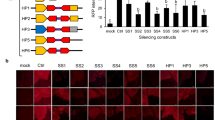Abstract
Post-transcriptional gene silencing (PTGS), a sequence-specific RNA degradation mechanism inherent in many life-forms, can be induced in plants by transforming them with either antisense1 or co-suppression2 constructs, but typically this results in only a small proportion of silenced individuals. Here we show that gene constructs encoding intron-spliced RNA with a hairpin structure can induce PTGS with almost 100% efficiency when directed against viruses or endogenous genes. These constructs could prove valuable in reverse genetics, genomics, engineering of metabolic pathways and protection against pathogens.

Similar content being viewed by others
References
Hamilton, A. J., Lycett, G. W. & Grierson, D. Nature 346, 284– 287 (1990).
Jorgensen, R. A. Science 268, 689–691 ( 1995).
Waterhouse, P. M., Graham, M. W. & Wang, M.-B Proc. Natl Acad. Sci. USA 95, 13959–13964 (1998).
Waterhouse, P. M., Smith, N. A. & Wang, M.-B Trends Plant Sci. 4, 452– 457 (1999).
Wang, M.-B, Upadhyaya, M. N., Brettel, R. I. S. & Waterhouse, P. M. J. Genet. Breed. 51, 325–334 (1997).
Okuley, J. et al. Plant Cell 6, 147–158 (1994).
Cartea, M. E., Migdal, M., Galle, A. M., Pelletier, G. & Guerche, P. Plant Sci. 136, 181– 194 (1998).
Rosche, E. & Westhoff, P. Plant Mol. Biol. 29 , 663–678 (1995).
Gleave, A. P. Plant Mol. Biol. 20, 1203–1207 (1992).
Stalberg, K., Ellerstrom, M., Josefsson, L. G. & Rask, L. Plant Mol. Biol. 23, 671–683 (1993).
Fire, A. et al. Nature 391, 806–811 (1998).
Sharp, P. A. Genes Dev. 13, 139–141 ( 1999).
Author information
Authors and Affiliations
Corresponding author
Additional information
brief communications is intended to provide a forum for short, topical reports of general scientific interest and for technical discussion of recently published material of particular interest to non-specialist readers. Priority will be given to contributions that have fewer than 500 words, 10 references and only one figure. Detailed guidelines are available on Nature's website (http://www.nature.com) or on request from nature@nature.com
Rights and permissions
About this article
Cite this article
Smith, N., Singh, S., Wang, MB. et al. Total silencing by intron-spliced hairpin RNAs. Nature 407, 319–320 (2000). https://doi.org/10.1038/35030305
Issue Date:
DOI: https://doi.org/10.1038/35030305
- Springer Nature Limited
This article is cited by
-
In planta RNAi targeting Meloidogyne incognita Minc16803 gene perturbs nematode parasitism and reduces plant susceptibility
Journal of Pest Science (2024)
-
Engineering resistance against Cucumber mosaic virus in Nicotiana tabacum through virus derived transgene expressing hairpin RNA
3 Biotech (2023)
-
Nucleotide mismatches prevent intrinsic self-silencing of hpRNA transgenes to enhance RNAi stability in plants
Nature Communications (2022)
-
Exogenous application of coat protein-specific dsRNA inhibits cognate cucumber mosaic virus (CMV) of ghost pepper
Journal of Plant Diseases and Protection (2022)
-
Increased rates of gene-editing events using a simplified RNAi configuration designed to reduce gene silencing
Plant Cell Reports (2022)





